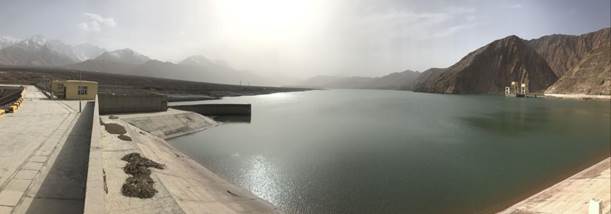Main Participants: HU Jian, DENG Anjun, XIAO Jun, YANG Shuhong, HU Zhengfu, GUO Chuansheng, ZHU Bisheng, WANG Dangwei, LI Xiao, LU Qin
Xinjiang is located in the inland arid area of China. As key nodes of water resources scheduling, reservoirs optimize the spatial distribution of water resources and ensure water resources security. Most rivers in Xinjiang are snowmelt rivers, with highly synchronized water and sediment variations, and acute contradiction between water storage and sediment discharge in reservoirs. Among the 520 reservoirs across the region, 272 are suffering from sediment deposition to different extent, which has affected the functions of 131 reservoirs. Sediment prevention and discharge is one of the key technical problems that call for urgent action in reservoir construction and operation.
The research on the key technologies for sediment discharge from sediment-laden reservoirs on snowmelt rivers is of practical significance to sediment discharge from existing reservoirs, which can help restore some effective capacity and ensure the normal function of reservoirs. The research findings can also provide scientific basis and reference for new reservoir projects in Xinjiang.
· Research on water and sediment characteristics, sediment movement mechanism, and sediment discharge threshold indexes of reservoirs on snowmelt rivers.
· Research on the sediment regulation scheme for reservoirs on snowmelt rivers.
· Research on the layout plan and rationality for flood and sediment discharge structures of sediment-laden reservoirs.
· Analysis of sediment regulation system and sediment discharge performance for reservoirs on snowmelt rivers.
· Having studied the mutual feedback mechanism between along-range and backward scouring of reservoir sediment, and the formation mechanism of scouring funnel under three-dimensional complex flow conditions through physical modeling experiments, and solved key technical problems such as selection of sediment discharge facilities for sediment-laden reservoirs, selection of the flow and water level for sediment discharge, and timing of sediment discharge.
· Having put forward an optimal water-sediment regulation system of dynamic water level and sediment discharge scheduling in sediment-laden reservoirs based on the characteristics of water and sediment from snowmelt rivers, and alleviated the contradiction between water resources utilization and sediment discharge from reservoirs.
· Having proposed a layout plan of high and low sediment discharge tunnels for large reservoirs and a layout plan of combined power generation and sediment discharge inlet towers for small and medium-sized reservoirs given the different water intake and sediment discharge needs of different types of reservoirs, providing a typical case for the layout of sediment discharge structures of reservoirs on snowmelt rivers.
· Having developed a sediment reduction and prevention mode of cascaded hydropower stations with one reservoir that replaces settling basins for sediment-laden rivers fed by melting snow, greatly reducing the cost of building sediment prevention and settling facilities at downstream cascaded power stations and solving the technical constraint in safe water intake for hydropower stations on sediment-laden rivers.
The research findings have eased the contradiction between the supply and demand of water resources caused by the special natural geographical and geological conditions in Xinjiang, and improved the allocation and utilization of water resources by existing reservoirs. The application of the phased sediment discharge scheduling based on dynamic water levels and the optimization of sediment discharge structures can effectively extend the service life of reservoirs and increase the time and efficiency of power generation. Based on the regulation of cascade reservoirs, the downstream reservoirs have replaced the settling basins, which has greatly reduced the costs for construction and future operation and maintenance.
The application and popularization of the research findings is of great significance to sediment discharge of both existing and future reservoirs in Xinjiang. Meanwhile, the rivers in South Asian countries such as Nepal, Indonesia and Pakistan are also mostly fed by melting snow, the research findings can be applied to sediment studies in the development of similar hydropower station projects in those countries.

Fig.1 The completed Karabelli Reservoir in Xinjiang

Fig.2 The completed Tazilga Reservoir in Xinjiang
Fig.3 The plan of sediment regulation operation at different water levels and by stages for sediment-laden reservoirs on snowmelt rivers
Fig.4 Layout plan of high and low sediment discharge tunnels for large reservoirs
Fig.5 The cascade development mode of sediment-laden reservoirs